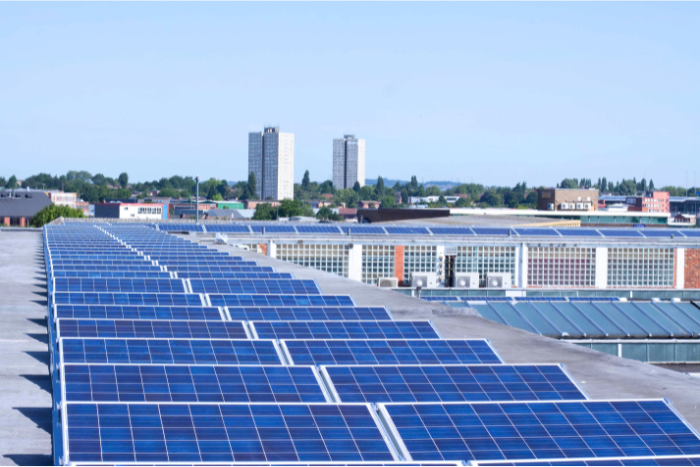At the 4th Global Renewable Energy Investor’s Meet and Expo (RE-INVEST), Indian states and Union Territories pledged significant renewable energy capacity targets to help achieve the national goal of 500 GW by 2030. Gujarat led with a commitment of 128.60 GW, followed by Andhra Pradesh (72.60 GW), Maharashtra (62.73 GW), Rajasthan (57.71 GW), and Uttar Pradesh (47.63 GW). Major developers like Reliance, NTPC, and Adani also pledged substantial contributions. The New and Renewable Energy Minister, Pralhad Joshi, announced that financial institutions have committed $386 billion for these projects, reflecting strong support for India’s green energy transition.
India’s solar imports decline over 16% in Q2 2024
In the second quarter of 2024, India’s solar imports dropped to 16.4% at over $774.9 million (~₹64.6 billion), according to government data cited by Mercom. The decline has been attributed to the Centre bringing back the Approved List of Models and Manufacturers (ALMM).
The report said solar modules accounted for 55% of the quarter’s imports, and solar cells 45%. The outlet explained that in a quarter-over-quarter (QoQ) comparison, solar module and cell imports dropped by 61.4% from over $2 billion (~₹166.9 billion). Solar module imports saw a sharp decline of 73.2%, while solar cell imports fell by 17%.
Mercom pointed out that the decrease in imports was largely due to the reimposition of the ALMM order on April 1, 2024, prompting developers to source ALMM-authorised modules domestically.
In Q2 2024, 67.8% of the solar imports were from China, down from 73% in the previous quarter.
About 23.9% of solar imports were from Vietnam, followed by Thailand, Cambodia, and Singapore, with 5.7%, 1.0%, and 0.8%, respectively, the energy research outlet reported.
Reliance to set up 20 GW solar module factory; plans to commercialise perovskite solar panels
By the end of 2024, Reliance will begin producing PV modules (cells, glass, wafers, ingots, and polysilicon), and by 2026 it will commercialise perovskite solar cells (perovskite semiconductors are cheaper, abundant and have more efficient crystalline structure than silicon ones), PV Magazine reported.
The $8.9 billion gigafactory will be able to produce 20 GW of modules, which will be “the world’s largest integrated manufacturing hub” for the solar value chain, battery energy storage systems (BESS), and electrolyzers in Jamnagar, Gujarat.
Reliance said its new energy business is developing heterojunction (HJT) bifacial solar panels with 26% efficiency. The company said it plans to commercialise perovskite and HJT with interdigitated back-contact (IBC) technology within the next two years.
Perovskite is more efficient than silicon in absorbing light but hasn’t been commercialised at scale yet. While silicon absorbs a broader spectrum of light, but it can’t cover it efficiently. Perovskites absorbs a smaller subset of spectrum, but it does it more efficiently, therefore they are used in tandem with silicon (a layer of perovskites is put on top of a layer of silicon, so that the perovskites absorb their part of the bandwidth, and the silicon absorbs its part of the bandwidth, thus capturing a much wider part of the spectrum).
Climate change dries up water in lake, Zambia forced to shut down hydropower plant
Zambia will be forced to shut down its hydropower generation unit after it was crippled by droughts. Climate change related drought has significantly depleted water levels of Lake Kariba, there’s not enough to generate hydropower, DTE reported.
The outlet added that the lake, shared by Zambia and Zimbabwe, is on the Zambezi river, one of Africa’s main rivers whose catchment areas have suffered from climate change-related droughts over the past few years.
The southern African region is currently reeling from the effects of a severe El Nino-induced drought, DTE explained, adding that these droughts and heightened evaporation from increased heat have caused the lake’s water levels to drop to record lows.
TotalEnergies strikes renewable energy deal with Adani Green with $444 million JV
Adani Green and Total Energies will form a joint venture in a deal, which will see the French oil giant contribute an equity investment of $444 million, Reuters reported.
The newswire reported that last year in September the two had formed a joint venture worth $300 million, which gave Total “direct access to ownership of assets” contributed by Adani Green — namely 1.05 gigawatts (GW) of wind and solar farms in India, where the bulk of energy requirements are still met by coal.
Adani Green said the new agreement, into which Total pays more money, will see each side hold 50% of another portfolio of 1.15 GW of solar electricity installations, both operational and under construction. The electricity will be sold on the wholesale market through power purchase agreements with Solar Energy Corporation of India, which would allow Total Energies to capitalise on the liberalisation of India’s power market.
About The Author
You may also like
Non-Fossil Fuels Generates One-Third of India’s Electricity in 2025
India on track to achieve 2030 clean energy target
India to add 45GW solar capacity in FY 2026: Study
Government Proposes for ALMM Expansion for Solar Backward Integration
China’s renewable energy expansion can fuel global energy transition: Report

